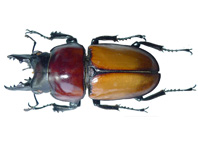Abstract
The spider genus Fecenia was erected by Simon (1887). Together with the genus Psechrus Thorell, 1878, Fecenia Simon, 1887 belongs to the family Psechridae Simon, 1890 (Platnick 2013), a group of araneomorph, entelegyne and cribellate spiders (Bayer and Jäger 2010). The presence of this spider genus in India, which belongs to the Lycosoidea within the retrolateral tibial apophysis (RTA)-clade (Griswold 1993; Griswold et al. 2005; Bayer and Schönhofer 2013), was first noticed by Thorell (1891), who described Fecenia protensa Thorell, 1891 from the Nicobar Islands. In 1899, Pocock (1899) described a second species, Fecenia travancoria from Kerala, a state in the south-west of India. Bayer (2011) recently revised the genus and proposed two junior synonyms for F. protensa: F. sumatrana Kulczyński, 1908 and F. nicobarensis Tikader, 1977. He also pointed out the striking similarities of the females of F. protensa and F. travancoria. Nevertheless, he provided ways to distinguish the females by very fine character differences of the vulva and listed five valid species for the genus (Fecenia) (Bayer 2011). Bayer & Schönhofer (2013) investigated the molecular taxonomy based on DNA sequence data from the cytochrome c oxidase subunit 1 (COI) gene of Fecenia specimens from all species described so far (except F. macilenta Simon, 1885) and found out that the COI sequence variation between specimens of F. travancoria and F. protensa was less than 4.7 %, whereas the COI sequence variation between other Fecenia spp. was at least 9%. They suggested that their findings indicated the synonymy of F. travancoria with F. protensa , but the male and further material of F. travancoria from the region of the type locality was unknown to them. Consequently, they did not propose a synonymy of these two species. Even though Sebastian and Peter (2009) described the female of F. travancoria from Kerala region, they neither provided any information about its male nor any information about intraspecific variation within its females. In the present paper, we describe and illustrate male Fecenia specimens from the region of the type locality of F. travancoria for the first time and by doing so, we are able to provide evidence for the synonymy of F. travancoria with F. protensa.

